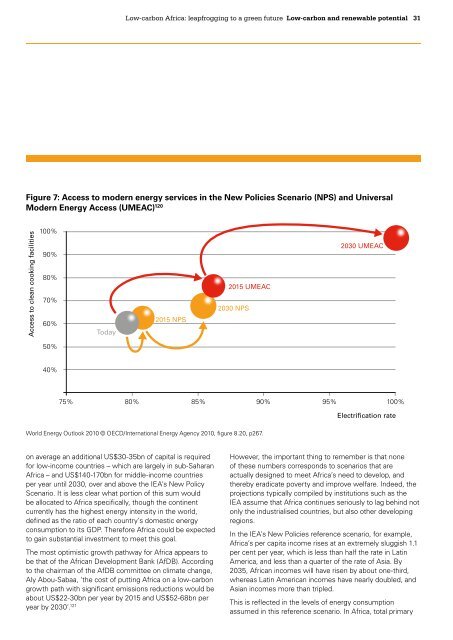Ju8uG
Ju8uG
Ju8uG
You also want an ePaper? Increase the reach of your titles
YUMPU automatically turns print PDFs into web optimized ePapers that Google loves.
Low-carbon Africa: leapfrogging to a green future Low-carbon and renewable potential<br />
31<br />
Figure 7: Access to modern energy services in the New Policies Scenario (NPS) and Universal<br />
Modern Energy Access (UMEAC) 120<br />
Access to clean cooking facilities<br />
100%<br />
90%<br />
80%<br />
70%<br />
60%<br />
Today<br />
2015 NPS<br />
2015 UMEAC<br />
2030 NPS<br />
2030 UMEAC<br />
50%<br />
40%<br />
75% 80% 85% 90% 95% 100%<br />
Electrification rate<br />
World Energy Outlook 2010 © OECD/International Energy Agency 2010, figure 8.20, p267.<br />
on average an additional US$30-35bn of capital is required<br />
for low-income countries – which are largely in sub-Saharan<br />
Africa – and US$140-170bn for middle-income countries<br />
per year until 2030, over and above the IEA’s New Policy<br />
Scenario. It is less clear what portion of this sum would<br />
be allocated to Africa specifically, though the continent<br />
currently has the highest energy intensity in the world,<br />
defined as the ratio of each country’s domestic energy<br />
consumption to its GDP. Therefore Africa could be expected<br />
to gain substantial investment to meet this goal.<br />
The most optimistic growth pathway for Africa appears to<br />
be that of the African Development Bank (AfDB). According<br />
to the chairman of the AfDB committee on climate change,<br />
Aly Abou-Sabaa, ‘the cost of putting Africa on a low-carbon<br />
growth path with significant emissions reductions would be<br />
about US$22-30bn per year by 2015 and US$52-68bn per<br />
year by 2030’. 121<br />
However, the important thing to remember is that none<br />
of these numbers corresponds to scenarios that are<br />
actually designed to meet Africa’s need to develop, and<br />
thereby eradicate poverty and improve welfare. Indeed, the<br />
projections typically compiled by institutions such as the<br />
IEA assume that Africa continues seriously to lag behind not<br />
only the industrialised countries, but also other developing<br />
regions.<br />
In the IEA’s New Policies reference scenario, for example,<br />
Africa’s per capita income rises at an extremely sluggish 1.1<br />
per cent per year, which is less than half the rate in Latin<br />
America, and less than a quarter of the rate of Asia. By<br />
2035, African incomes will have risen by about one-third,<br />
whereas Latin American incomes have nearly doubled, and<br />
Asian incomes more than tripled.<br />
This is reflected in the levels of energy consumption<br />
assumed in this reference scenario. In Africa, total primary


